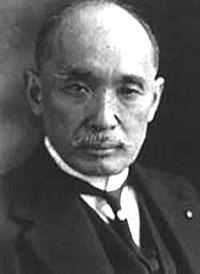Nationality Japan Education University of Tokyo Parents Okubo Toshimichi | Role Japanese statesman Name Makino Nobuaki Grandparents Okubo Juemon | |
 | ||
Occupation Politician, Cabinet Minister, Diplomat Died January 25, 1949, Tokyo, Japan | ||
Count Makino Nobuaki (牧野 伸顕, November 24, 1861 – January 25, 1949) was a Japanese statesman, active from the Meiji period through the Pacific War.
Contents
Early life and education
Born to a samurai family in Kagoshima, Satsuma Domain (present day Kagoshima Prefecture), Makino was the second son of Ōkubo Toshimichi, but adopted into the Makino family at a very early age.
In 1871, at age 11, he accompanied Ōkubo on the Iwakura Mission to the United States as a student, and briefly attended school in Philadelphia. After he returned to Japan, he attended Tokyo Imperial University, but left without graduating.
Career
Makino entered the Foreign Ministry. Assigned to the Japanese London Embassy, he made the acquaintance of Itō Hirobumi.
After serving as governor of Fukui Prefecture (1891–1892) and Ibaraki Prefecture (1892–1893), Ambassador to the Austro-Hungarian Empire and Ambassador to Italy, he served as Minister of Education under the 1st Saionji Cabinet, and as Minister of Agriculture and Commerce under the 2nd Saionji Cabinet. He was also appointed to serve on the Privy Council. Under the 1st Yamagata Cabinet, he was appointed Foreign Minister. Makino aligned his policies closely with Itō Hirobumi and later, with Saionji Kinmochi, and was considered one of the early leaders of the Liberalism movement in Japan. He was appointed to be Japan's ambassador plenipotentiary to the Paris Peace Conference of 1919, ending World War I. Makino and his delegation put forth a racial equality proposal at the conference which did not pass.
In 1907, Makino elevated in rank to danshaku (baron) under the kazoku peerage system. In 1913, Makino became Minister of Foreign Affairs. On September 20, 1920, he was awarded the Grand Cordon of the Order of the Rising Sun with Paulownia Flowers. In February 1921, he became Imperial Household Minister and elevated in rank to shishaku (viscount). Behind the scenes, he strove to improve Anglo-Japanese and Japanese-American relations, and he shared Saionji Kinmochi's efforts to shield the Emperor from direct involvement in political affairs. In 1925, he was appointed Lord Keeper of the Privy Seal of Japan. He relinquished the post in 1935, and was elevated in title to hakushaku (count). Although he relinquished his positions, his relations with Emperor Shōwa remained good, and he still had much power and influence behind the scenes. This made him a target for the militarists, and he narrowly escaped assassination at his villa in Yugawara during the February 26 Incident in 1936. He continued to be an advisor and exert a moderating influence on the Emperor until the start of World War II.
Later life and death
Makino was also first president of the Nihon Ki-in Go Society, and a fervent player of the game of go.
After the war, his reputation as an "old liberalist" gave him high credibility, and the politician Hatoyama Ichirō attempted to recruit him to the Liberal Party as its chairman. However, Makino declined for reasons of health and age. He died in 1949, and his grave is at the Aoyama Cemetery in Tokyo.
Legacy
Noted post-war Prime Minister Yoshida Shigeru was Makino's son-in-law, and the former Prime Minister, Asō Tarō, is Makino's great-grandson. In addition, Ijuin Hikokichi, former foreign minister, was brother-in-law of Makino.
